Boxes / Desk
Boxes / Desk
Browse our collection of antique silver Boxes, Miniature Items, Inkstands and Desk Related Objects
Small Silver and Gold Boxes, Vinaigrettes, Snuff Boxes, Tea Caddies, Biscuit Boxes, Cases, Cigar Boxes, Speciality Boxes etc.
Since antique times caskets have been used to keep important documents and jewels. In England silver boxes (and gold) in a various of shapes and sizes became popular in the seventeenth century. Small boxes, designed for many diverse uses – counters, snuff, vestas, tobacco, vinaigrettes, scent, nutmeg, toothpicks, toilet boxes. Larger boxes, made for specific storage requirements, including tea, sugar, biscuits, cigarettes and cigars. The jewellery box remains as popular today as it did in ancient times.
Miniature Boxes, Dishes, Toys, Models, Kitchenware and Musical Instruments
Silver toys originated in Europe during the 17th century and were made initially for the children of kings and queens. At that time England was still suffering under Puritanism and it wasn’t until the Restoration of Charles II in 1660 that silver toys were made available in this country. The earliest English silver toys date from 1665 and were made in London; it was uncommon for toys to be made in the provinces. The Dutch were the leading manufacturers of silver toys, their most prolific period being 1725-1750, and by then wealthy royalty, landowners and business men were buying toys for their own pleasure as well as that of their children’s.
The Traveller’s Sample would be an exact copy of a full size original. The great attention to detail and slightly larger size than normal toys of this period generally indicates this purpose.
Inkstands and Inkwells. Desk Accessories, Bells, Pens, Letter Openers, Seals
The inkstand did not enter into common household use until the 18th century. Earlier 17th century examples exist but are exceedingly rare. The main requirement was a container for ink and another for sand (or pounce) which was used for drying the ink. Also required was a space to put quills. Some inkstands also incorporated a taper stick for melting sealing wax or even a bell.
Desk accessories form a wide and interesting collecting field and they make an excellent gentleman’s gift. It’s thought that the first handwritten letter was written, probably on canvas, by a Persian queen in around 500BC. Letters were vital for basic communication, both personal and formal, and were governed by basic rules of etiquette. The equipment required to write a simple letter was quite extensive including paper, envelope, pen, ink, blotter, stamps. Once written the letter or scroll needed to be sealed using a candle wax kit. Letter openers are useful gifts.
-

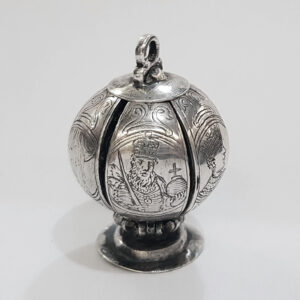
Circa 1600 - 1620
10349 17th Century Antique Silver Pomander
Sold
An intriguing piece of history contained in a small silver sphere. The antique silver pomander was worn round the neck or suspended from a belt and was intended to protect the wearer from sickness. The exterior of this example is hand engraved with royal portraits, probably English, based on engravings by Simon de Passe (c. 1595 – 6 May 1647). The screw top unturns to release six hollow, hinged segments to contain dried flowers, spices and scented oils. The interior is decorated with scroll and hatched engraving. A similar example formed part of the prestigious David Little collection. Weight 22 grams, less than 1 troy ounce. Height 3.9cm. Spread 5.6cm fully extended. Unmarked silver. Probably English. Circa 1600-20.
-

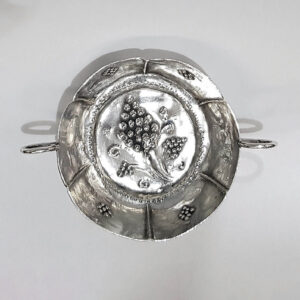
Circa 1670
10393 Charles II Antique Silver Miniature Wine Taster
A charming little early English miniature dish from the reign of Charles II. Very sweet size. This little cup has a circular form with simple wirework handles and an embossed grape decoration. Owner’s initials “AA” engraved to the top rim. Weight 12 grams, less than half a troy ounce. Height 1.5 cm approx. Diameter of top 5.2cm. Spread across handles 7.4cm. English, circa 1670. Unmarked sterling silver.
-

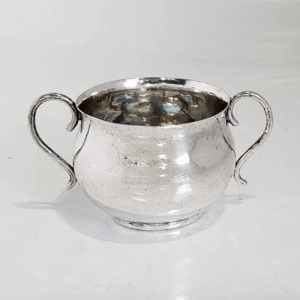
1673
8394 Charles II Antique Silver Brandy Cup
A rare early English silver tot cup, or small size porringer, with twin side handles and belly shape. Lovely original hand beaten finish. Lovely original hand beaten finish. Weight 69 grams, 2.2 troy ounces. Height 5.5 cms. Diameter 6 cms. London 1673. Maker IC* listed in Jacksons.
-

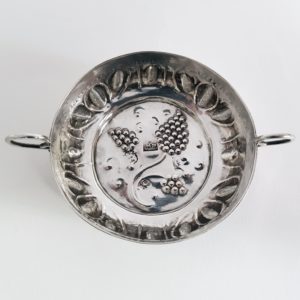
1673
George Watkins
10182 Charles II Antique Silver Wine Taster
A rare early English miniature wine taster from the reign of Charles II. Very charming size. This little cup has a circular form with simple wirework handles and embossed grape decoration. Weight 21 grams, less than 1 troy ounce. Height 2 cm approx. Diameter of top 6.1cm. Spread across handles 8.9cm. London 1673. Made by George Watkins. Sterling silver.
-

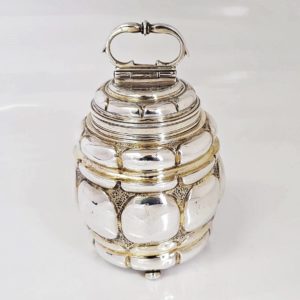
1675 - 1679
Marx Schaller
9789 Antique German Silver Tea Cannister
A 17th century German parcel-gilt silver caddy of barrel shape. With a screw top lid and drop ring handle. Beautifully made and very tactile to hold. Suitable for tea and sugar. Raised on four ball feet, the box is decorated throughout with silver lobes against a matted gilt background. Weight 321 grams, 10.3 troy ounces. Height 11.5cm (to the top), 15cm (to top of handle). Stamped on the top and underside of body with German silver marks and assay scrape for Augsburg, Germany. Maker Marx Schaller II. Circa 1675-79. See Rosenburg German silver marks for Augsburg page 127.
-

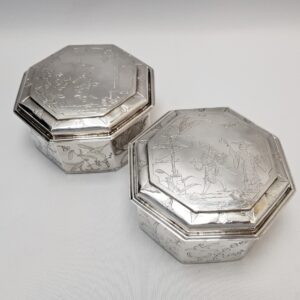
1680
Ralph Leake
10419 Pair of Charles II Antique Silver Boxes
An outstanding pair of 17th century silver toilet boxes of octagonal form with pull off lids. Good size and weight. The charming decoration is a superb example of the flat chased chinoiserie style popular in the late 1600’s. Each box depicts a different scene incorporating two Chinese figures within a backdrop of architectural ruins and exotic plants and birds. At this date boxes of this type would have originally been part of an extensive toilet service. Weight 738g, 23.7 troy oz. Width 13.7cm, 5.4 inches. Height 7.2cm, 2.8 inches. London 1680. Maker Ralph Leake. Sterling silver.
-


1686
10450 James II Antique Silver Chamberstick
Sold
A distinctive little chamberstick (or “go to bed”) with the solid design and heavy gauge silver you’d expect from this date. It has the early form with a flat teardrop handle engraved with a family coat of arms. The circular pan has a gadrooned border and ribbed sconce, all mounted on three small stump feet. Weight 187g, 6 troy oz. Height 4.3cm. Diameter 9.7cm. Spread 15cm, 5.9ins. London 1686. Maker’s mark unclear. Sterling silver.
-

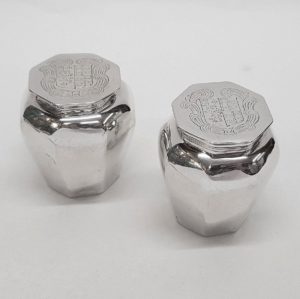
Circa 1690
Anthony Nelme
9371 17th Century Antique Silver Boxes
A pair of early English antique silver toilet jars with lift off lids. Plain octagonal form. The tops have a hand engraved armorial within plumage feathers, typical of the Charles II/James II period. These unusual miniature toilet jars are very charming. Superb antique colour. At this date boxes of this type would have originally been part of an extensive toilet service. Total weight 148 grams, 4.7 troy ounces. Height 6cm. Diameter of lid 3.8cm. Makers mark only for Anthony Nelme. Circa 1690. Sterling silver.
-

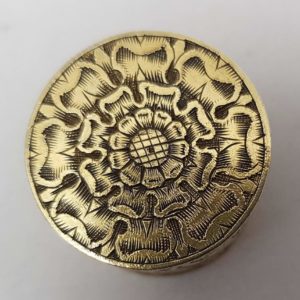
Circa 1690
10212 17th century Antique Silver Counter Box
An antique silver counter box of typical cylindrical form. The hand engraved decoration is very unusual having a finely worked matted and hatched background. The pull-off cover is decorated with the Tudor rose, the sides with cherubs, fruit and foliage. Weight approx.10 grams, 0.4 troy ounces. Diameter 2.1cm. Height 1.8cm. Probably English. Circa 1690. Unmarked silver. 17th century.
Literature. Counter boxes contained a number of disks, commonly stamped or engraved with portraits of English monarchs, that were used as game markers and counting devices. Counter boxes were rarely marked.
-

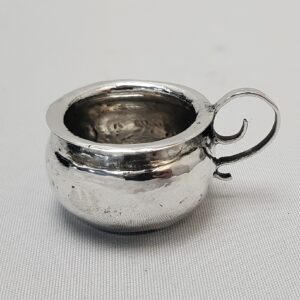
Circa 1690
Charles Eystone
10394 William & Mary Antique Silver Miniature Chamber Pot
Sold
A charming little doll’s house piece. This rare miniature antique silver potty is made of hand beaten sheet silver with a simple scrolled handle. It dates to the second half of the 1600’s. Weight 13g, less than half a troy oz. Spread 4.9cm. Diameter 3.4cm. Height 2.5cm (to top of handle). London, circa 1690. Maker Charles Eystone. Sterling silver.
-

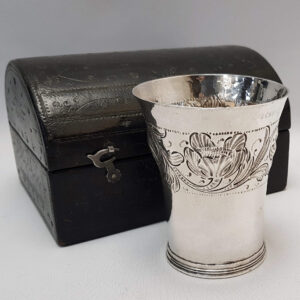
1691
John Duck
10420 William and Mary Antique Silver Beaker
A superb 17th century antique silver cup of tapering form cylindrical decorated with an exuberant floral design typical of the second half of the 1600’s. Prick engraved “1691” below the rim. An attractive feature is the domed leather presentation casket (circa 1780), the swivel hooks made of silver, the underside covered in marbled paper. Contains 200ml.
Weight 3.8 troy oz, 119g. Height 9.3cm, 3.5ins. Diameter 15.25cm, 6 ins. London 1691. Maker John Duck, well known for his fine period beakers. Sterling silver. -

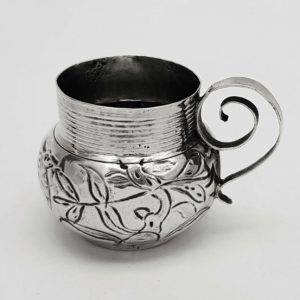
1693
George Manjoy
9539 William & Mary Antique Silver Miniature Mug
A delightful little collector’s piece. This rare miniature (or toy) mug is an exact copy of a full size original. Of globular form it has a reeded and incised neck, and double scroll handle. This style was only made for a short period at the end of the 17th century and is the earliest type of mug you are likely to come across. The body is engraved with an exotic bird and leafy branches. Weight 14 grams, less than 1/2 troy ounce. Height 3.5cm. Spread 4.9cm. London 1693. Maker George Manjoy, a specialist toy maker.
-


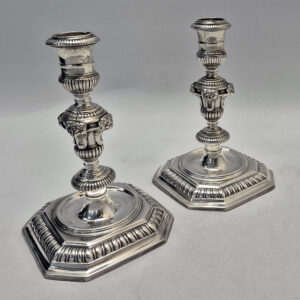
1694
John Laughton
10432 William III Antique Silver Candlesticks
Sold
A superb pair of early English desk candlesticks with square bases and lobed, gadroon decoration. The applied lion masks are extremely charming. The technique of making cast silver sticks was introduced into England circa 1685 and this is one of the early designs. Excellent quality and heavy gauge of silver. Total weight 750g, 24.1 troy oz. Height 15.5cm. Base 10.7cm. London 1694. Maker John Laughton. Sterling silver. 17th century.
-



1695
John Laughton
10433 William III Antique Silver Candlesticks
Sold
A superb pair of early English desk candlesticks with square bases and lobed, gadroon decoration. The applied lion masks are extremely charming. The technique of making cast silver sticks was introduced into England circa 1685 and this is one of the early designs. Excellent quality and heavy gauge of silver. Total weight 750g, 24.1 troy oz. Height 15.5cm. Base 10.7cm. London 1695. Maker John Laughton. Sterling silver. 17th century.
-

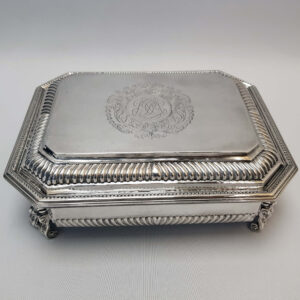
1697
Joseph Ward
10402 William III Antique Silver Casket
Sold
A substantial early English silver box of plain rectangular form, having canted corners and broad gadrooned banding. Very rare. Excellent size. The top has a large hand engraved cartouche containing a decorative cypher. Weight 1133g, 36.4 troy oz. Top measures 25cmx18.5cm. Height 8.5cm. London 1697. Maker Joseph Ward. Britannia standard silver, 95.8% pure.
-

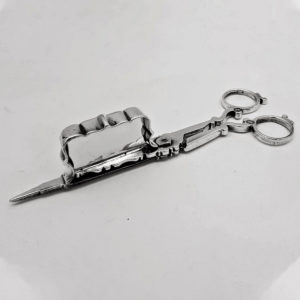
1701
Thomas Brydon
10371 William III Silver Snuffer Scissors
Sold
A rare early English silver candle douter, also called a wick trimmer, with the simple plain style typical of the period. *Britannia standard silver. Weight 94 grams, 3 troy ounces. Length 15.9cm. Width 5.5cm. London 1701. Few snuffers were made prior to 1700. Maker Thomas Brydon, see Jackson’s Silver & Gold Marks page 154, a known snuffers and stand maker.
-

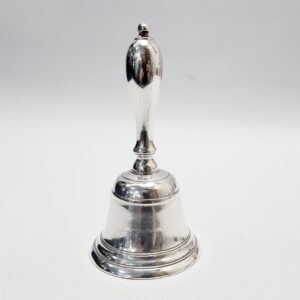
1701 - 1720
David Greene
10384 George I Antique Silver Bell
Sold
A rare early English silver hand bell from the early 1700’s. Lovely plain style with concentric bands around the centre and bottom rim. Heavy cast silver. Weight 207g, 6.6 troy oz. Height 13.3cm. Diameter 6.7cm. Owner’s initials “MP” engraved to the top of the handle. London circa 1701-1720. Maker David Green. Britannia Standard silver, 95.8% purity.
-

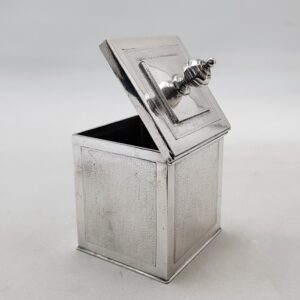
1704
Thomas Parr
10352 Queen Anne Antique Silver Tea Caddy
Sold
An extremely rare collector’s item dating to the early 1700’s. This unique little silver tea box of cube form has a hinged lid with octagonal finial. The hand applied matted work is very specific to the 1680-90 period. The small size is due to the rarity of tea at this early date. Weight 203g, 6.5 troy oz. Height 9cm (finial), 7cm. Top measures 6.3cm square. London 1704. Maker Thomas Parr I. Britannia standard silver.
-

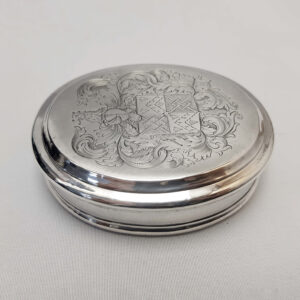
1710
Edward Cornock
10423 Queen Anne Antique Silver Tobacco Box
A charming early English silver box of plain oval form. The pull-off cover with a large, crisp armorial within a decorative cartouche for Harrington quartering Moodie (Mudie). This style was popular from the mid-17th century up until the reign of George I. Weight 122g, 3.9 troy oz. Length 9.2cm. Width 7.4cm. Height 2cm. London circa 1710. Maker Edward Cornock.
Britannia standard silver, high purity 95.8%. -

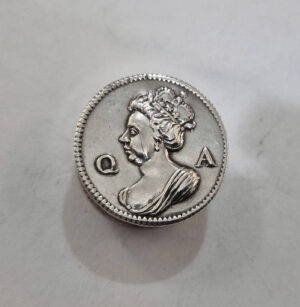
Circa 1710
Thomas Kedder
10454 Queen Anne Antique Silver Box
Sold
A charming little historical item. An early 18th century silver counter box of small size containing 11 embossed gaming counter/medalettes. The pull off cover is embossed with a portrait bust of Queen Anne between “Q and A”. Prick dot owner’s initials “EW” below. Weight 11g. Diameter 2.4cm, 0.95ins. Height 1.1cm, 0.4ins. Maker Thomas Kedder, a known box maker of the period. Circa 1710. Unmarked silver.
-

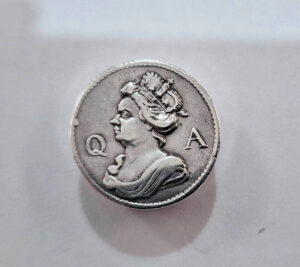
Circa 1710
Thomas Kedder
10459 Queen Anne Antique Silver Box
An interesting little silver counter box from the reign of Queen Anne. Small size. It contains four embossed gaming counter/medalettes. The pull off cover has a bead border and is embossed with a portrait bust of Queen Anne between “Q and A”. Weight 8g. Diameter 2.3cm, 0.9ins. Height 1cm, 0.39ins. Maker Thomas Kedder, a known box maker of the period. Circa 1710. Unmarked silver.
-


Circa 1710
10463 Queen Anne Antique Silver Box
A collectible little silver counter box dating from the early 1700’s. Small size. Contains one embossed gaming counter/medalette. The pull off cover is embossed with a portrait bust of Queen Anne between “A and R”. Weight 5g. Diameter 2.3cm, 0.9ins. Height 1.2cm, 0.47ins. Maker’s mark only “IA”. Circa 1710. Unmarked silver.
-

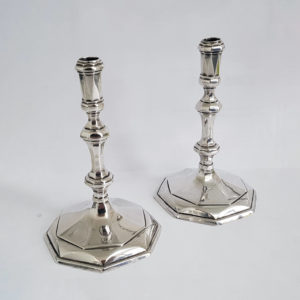
1712
Joseph Bird
10232 Queen Anne Antique Silver Tapersticks
A rare pair of dainty little antique silver tapersticks with the desirable octagonal shape. Superb quality. Lovely crisp finish. The straight lined form features a faceted sconce and foot and a plain knopped tapering stem. Total weight 200 grams, 6.4 troy ounces. Height 12cm. Base diameter 7.1cm. London 1712. Maker Joseph Bird. Britannia standard silver. 18th century.
-

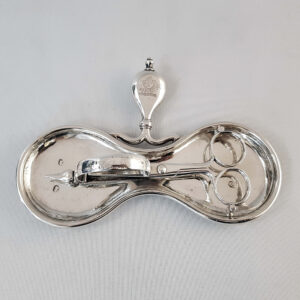
1716
George Gillingham
10418 George I Antique Silver Snuffer Tray and Scissors
Sold
It’s unusual to find a completely matching candle snuffer set from this early date, particularly with these attractive features. The scissor stand has an hour glass form, with the flat teardrop handle and small ball feet similar to early chambersticks of that date. The candle douter and wick trimmer has a simple open and shut mechanism and retains the original steel cutting plates, the pointed end was used to loosen and remove candle stubs from the socket. Both pieces bear the attractive hand engraved crest of a stallion horse.
-


1718
John Farnell
10303 George I Antique Silver Tea Caddy
Sold
A good early English silver caddy of plain rectangular design with the plain hexagonal design typical of the early 1700’s. The sliding top has a lift off cap which doubles as a tea measure. Weight 226 grams, 7.2 troy ounces. Height 12.6cm. Base 8.9 x 5.8cm. London 1718. Maker John Farnell. Britannia standard silver – purity 95.8%*. 18th century.
-

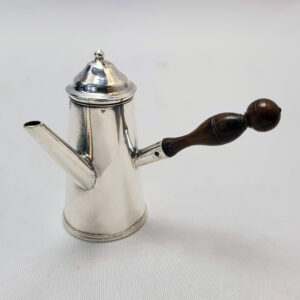
Circa 1720
David Clayton
10403 George I Antique Silver Miniature Silver Chocolate Pot
Sold
A charming little antique silver toy coffee pot with a typical early 1700’s design having tapering sides, straight spout, and a turned wooden side handle. This is an exact copy of a full size original. Weight 17 grams, under 1 troy ounce. Height 5.5cm. Spread 6.5cm. Diameter of base 2.7cm. London circa 1720. Maker David Clayton. Sterling silver.
-

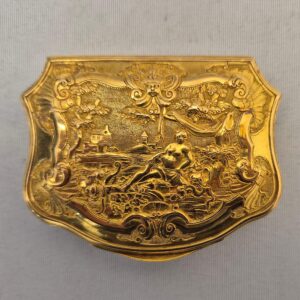
Circa 1720 - 1730
10437 George I Antique Gold Snuff Box
A sumptuous early 18th century gold box of cartouche form with a hinged lid. The top panel is chased with the classical goddess Diana reclining in a forest setting with an Apollo mask above. The shaped side panels are decorated with dogs and birds. There is an old German or Austrian collector’s label attached inside. Supplied with later fitted blue box.
Weight 68g, 2 troy oz approx. Width 6.5cm, 2.5ins. English, Dutch or German. Circa 1725. Solid gold, high grade probably 18 or 22ct. -

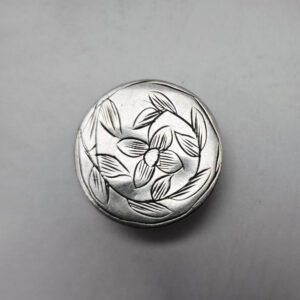
Circa 1720
William Paradise
10455 George II Antique Silver Box
Sold
A sweet little antique silver box with a pull off cover. Tiny size, possibly for pills or counters/tokens. The lid has a hand engraved flower and leaf design in the late 17th century style. Weight 3g. Diameter 1.9cm, 0.75ins. Height 0.9cm, 0.35ins. Maker possibly William Paradise. Circa 1720. Unmarked silver.
-


1722
Matthew Cooper
10448 George I Antique Silver Taperstick
An elegant little antique silver taperstick with knopped stem and rectangular base. Classic plain style and straight lines. Hand engraved to the foot is the crest of a fleur de lys with crown below. Cast silver. Weight 101 grams, 3.2 troy ounces. Height 9.8cm, 3.8ins. Diameter of base 6.7cm, 2.6ins. London 1722. Maker Matthew Cooper. Sterling silver.
-

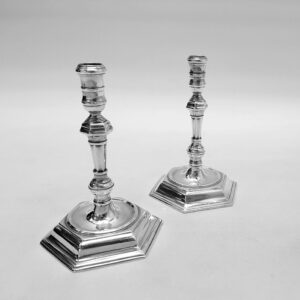
1724
John Bache
10302 George I Antique Silver Tapersticks
A delightful pair of little antique silver taper sticks with the plain hexagonal design typical of the early 1700’s. Cast silver. Total weight 235 grams, 7.5 troy ounces. Height 11.4cm. Base measures 7 x 8cm. London 1724. Maker John Bache. Britannia standard silver – 95.8% purity*. 18th century.
-


Circa 1725
10442 18th Century Antique Gold Box
An exquisite little antique gold patch box of circular form with excellent quality chased decoration. Very crisp. Lift off lid. Excellent colour. Weight 33g, 1 troy oz. Height 1.5cm, 0.59ins. Probably Augsburg, Germany. Circa 1725. Solid gold, probably 18 carat.
-

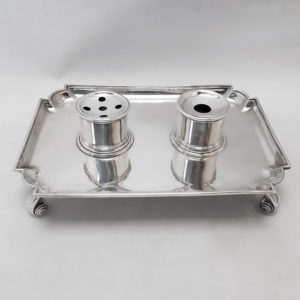
1726
John Edwards II
10243 George I Antique Silver Inkstand
Sold
A rare early English silver standish of plain rectangular design raised on large scroll feet. Sterling silver. Mounted on top are two circular containers for ink and sand. Excellent weight 999 grams, 32.1 troy ounces. Base height 5 cms, length 28 cms, width 19.5 cms. Ink bottle height, 5 cms, diameter 5.75 cms. London 1726. Maker John Edwards.